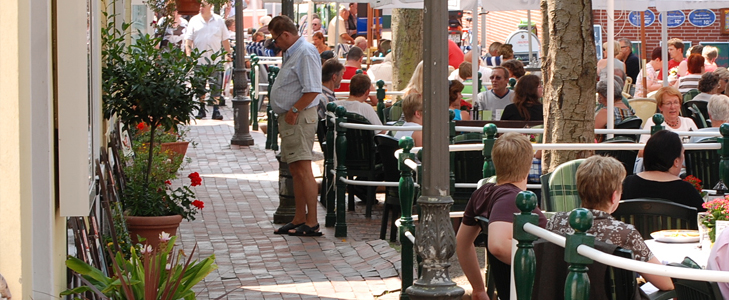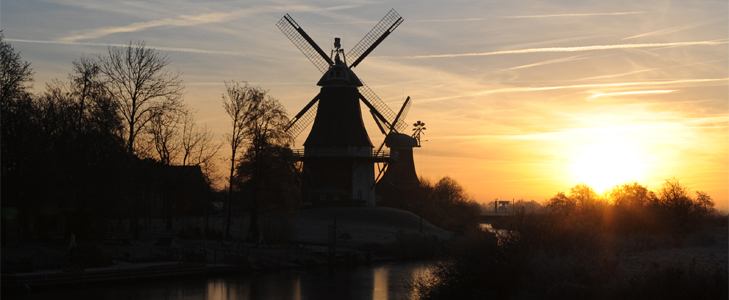 |
 |
 |
 |
 |
Greetsiel
Legal documents referring to Greetsiel are mentioned for the first time in letters from the year 1388 (Ocko tom Brock). At that time ships from Hamburg anchore in Greetsiel's port and owners were obliged to pay duty.
The town was founded out of the domain of Appingen by the chiefs of the Cirksena. While Appingen's importance diminished over time, Greetsiel grew to become the rulers' new seat.
Today the town has 1500 inhabitants.

Along with the following towns, Greetsiel belongs to the district of Krummhörn: Campen, Canum, Eilsum, Freepsum, Grimersum, Groothusen, Hamswehrum, Jennelt, Loquard, Manslagt, Pewsum, Pilsum, Rysum, Uttum, Upleward, Visquard, Woltzeten, Woquard. Through communal reform in 1972 these 19 towns were joined with Krummhörn as a political unit. The distance between the towns of Emden and Norden is 15 to 20 km.
Greetsiel is known primarily for its scenic harbor and for its twin windmills. In the last decades, the port and historical buildings in the town center have served as location for cinema and television films. Especially well known is the Pilsumer lighthouse, which is about 3 km distant from Greetsiel.
Numerous restaurants, inns and businesses, which are also open on weekends, invite visitors to stay a while. Whether hotel, pension, holiday apartment, or vacation house, Greetsiel has somethng to suit almost any demand.
From Greetsiel you can make day trips on the mainland or to islands just off the coast.
By means of roads on the dikes and paths in the fields, you can tour the villages of Krummhörn easily by bike or on foot.
Most villages in the Krummhörn are built on "Rundwarften" (circular, artificial earthen mounds designed as protection from flood waters). On the highest point stands the church. When these dikes first came into being is difficult to say. Estimates range from 1000 A.D. to the 12th Century.A.D..
The character of the inhabitants of East Frisia has, of course, been stamped by the landscape as well as by the continuous fight against the sea. Also typical is the dialect -- "Platdeutsch" -- that is spoken here. For example, a quote from Georg Fleßners contribution to the book "Uns...Billerbook" published by Cramer-Druck in 1985:
Greetsiel - Well na Greetsiel kummt, sücht al van wieden de twee Windmöhlens, de hör Flögels bi gaude Wind immer noch dreihn. An de Straten na Greetsiel stahn Bomen, de sük bagen hemm, van Wind und Störm. In de lüttje Haben von Greetsiel liggen de Fiskutters. De Netten sünd noch natt un swar van't Soltwater, un en heel Bült Lü kieken tau, wenn de Granat an Land sett' word un wenn de Kutters in de Haben dreihn, um na hör Stä to komen.
Midden in't Laug steiht de Kark, 500 Jahr olt ......
The translation: Whoever comes to Greetsiel sees first from a distance the two windmills, whose wings are still turning in a good (light) wind. Along the streets to Greetsiel stand trees that are bent by wind and storm. Fish cutters lie at anchor in the harbor. The nets are still wet with saltwater and lots of people watch as shellfish are brought on land and cutters turn in the harbor to moor at their docks. In the middle of the village stands the church, 500 years old . . .
The East Frisian Area: Geographically, the East Frisian-Oldenburgian peninsula on the outermost northwest coast of Germany is called East Frisia. This region includes the islands along the coast, as well as the mainland area, which consists of areas of salt marsh, "Geest"(expanses of sandy soil and dunes) and moor.
The drying of coastal marshland behind dikes, the cultivation of moors ("Fehnlandschaften" or fens) and the new agricultural classification of Geest areas has created a landscape with many special features.
Tourism, recreation and holiday industries form the major commercial basis for the Region. A large part of East Frisia is dedicated to wildlife preserves such as the FFH/Bird Sanctuaries and the National Park of Lower Saxony "Wattenmeer" (an area of low-tide shallows ranging form 5 to 30 km along the coast) and the Flumm-Fehntjertief.
















